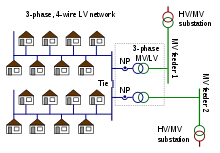Spot network substation
In electricity distribution networks, spot network substations (network transformers) are used in interconnected distribution networks. They have the secondary network (also called a grid network) with all supply transformers bussed together on the secondary side at one location. Spot networks are considered the most reliable and most flexible arrangement of connecting power to all types of loads.[1] Switching can be done without interrupting the power to the loads.

Description
Electricity distribution networks are typically of two types, radial or interconnected. A radial network arranges the station and branches like a tree with no connection to any other supply. This is typical of long rural lines with isolated load areas. In general, the radial distribution network has more power failures than the interconnected distribution networks.
In a secondary network the transformers are distributed across an area (e.g. in streets) and have multiple supplies. The transformers are wired together on the secondary side. The system is arranged so that nearby transformers do not use the same feeder. In case of an issue with a feeder (or transformer) the load is fed by nearby transformers, so there is no interruption, although a voltage drop for said load may then be present. Usually a fault on the secondary side is not a big problem since the conductors will destroy themselves.
A spot network is basically a secondary network condensed to a point. Several transformers have multiple supplies and their secondaries are bussed together. Besides a region-wide blackout, they are vulnerable to a bus fault, which is extremely rare. The simplest case is where each transformer connects to one feeder and vice versa ("unit system"). High-voltage switching can be used to handle more cases, e.g., working transformer but faulty feeder or the reverse.
Urban (spot) network transformer substations can be used to make interconnected distribution networks to serve a single facility. Examples of such single facilities include airports, hospitals, major data processing centers (especially those using uninterruptible power supply), and sports arenas that regularly broadcast nationally televised events.
In large cities, many electric utility companies use grid feeders to make interconnected distribution networks to serve the downtown core. The interconnected network has multiple connections to the points of supply.
Network protectors, (reverse current relays), are used to detect any open circuits that are letting the electrical current flow back towards its source.
Examples
Some of New York’s downtown is powered by submersible network transformers of 500 to 2,500 kVA. Usually these transformers are in vaults below metal grates in the sidewalks.[2]
A local spot network of two to eight primary transformers can be connected to the same secondary bus to provide reliable power to a particular facility, like a large hospital or computer and major data processing center. St. Jude Children's Research Hospital in Memphis, Tennessee has eight primary transformers that are connected to the same secondary bus.
The FedExForum (home of the NBA Grizzlies basketball team) in Memphis has a network of four primary transformers connected to the same secondary bus. In some arrangements with four transformers, any of the transformers can carry all of its connected loads.
The Toronto Pearson International Airport is electrically fed by four grid feeders, each capable of carrying the entire 20+ MW load.[3]
References
- EEP - Electrical Engineering Portal | Power Substation / Transmission and Distribution Spot network systems for distribution of electric power in downtown areas of cities By Edvard | April, 24th 2019
- ABB Special Report on Transformers | Page 26 of 76
- Toronto Pearson International Airport, see page 13 of 15
External links
- NIH Design Requirements]
- High containment (BSL-3/ABSL-3) facility electrical design | different primary substations or by one double-ended utility substation
for the Ontario Energy Board